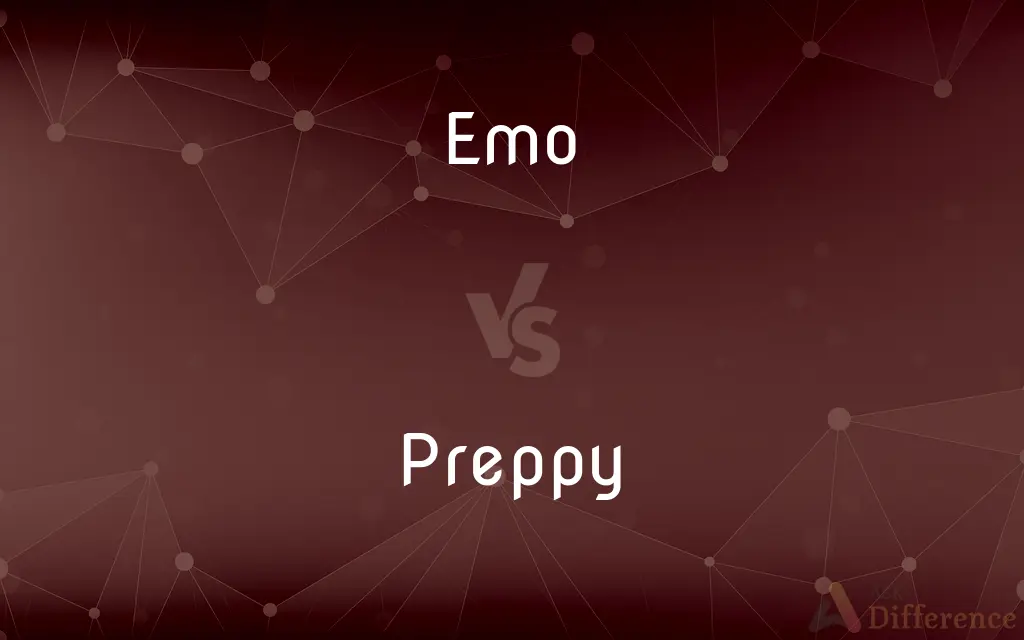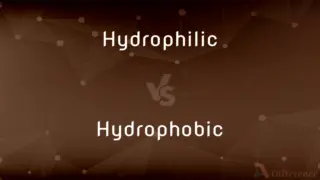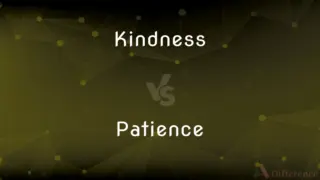Emo vs. Preppy — What's the Difference?
By Fiza Rafique & Maham Liaqat — Updated on March 13, 2024
Emo is associated with emotional expression, often through music, fashion, introspection, characterized by darker themes and attire. Preppy is a style originating from the US East Coast's collegiate scene, embodying a clean, polished look.

Difference Between Emo and Preppy
Table of Contents
ADVERTISEMENT
Key Differences
The emo style emphasizes emotional depth and introspection, often reflected in music genres like emo-rock, and is characterized by darker clothing, skinny jeans, band T-shirts, and sometimes dramatic hairstyles and makeup. This style is about expressing individuality and often deals with themes of emotionality, sensitivity, and personal turmoil. On the contrary, preppy fashion is inspired by the Ivy League style, featuring a more conservative and traditional look with items like khakis, polo shirts, blazers, and loafers. It embodies an affluent, collegiate lifestyle, often associated with outdoor sports like sailing and polo.
While emo culture tends to highlight personal and emotional experiences, often with a darker or more introspective outlook, preppy culture leans towards a more optimistic, outgoing lifestyle, emphasizing social status and conformity to traditional styles. The emo aesthetic can be seen as a form of rebellion against mainstream norms and a way to connect with others who share similar feelings of alienation or emotional depth, whereas the preppy style aligns more with mainstream, established social norms, often reflecting a desire for a polished, socially acceptable appearance.
In terms of community and identity, those identifying with the emo subculture might find solace and community in music venues, online spaces, or social groups that share a deep interest in music, art, and alternative fashion. Preppy individuals, however, may gravitate towards more traditional social settings like country clubs, universities, and professional environments that reflect their values of success, tradition, and conformity.
Both styles serve as a means for individuals to express their identities and align themselves with communities that share similar values and interests. While the emo subculture might use fashion and music as outlets for emotional expression and coping with life's complexities, the preppy style often serves as a symbol of success, tradition, and a connection to the collegiate, East Coast lifestyle.
Comparison Chart
Inspiration
Emotional expression, alternative music.
Ivy League, collegiate lifestyle.
ADVERTISEMENT
Fashion
Darker themes, skinny jeans, band tees.
Khakis, polo shirts, blazers, loafers.
Themes
Introspection, sensitivity, turmoil.
Optimism, social status, tradition.
Lifestyle
Alternative, often introspective.
Collegiate, outdoor-oriented, traditional.
Music Influence
Emo-rock, punk, indie.
Classic rock, pop, country club genres.
Social Setting
Music venues, online communities.
Country clubs, universities, professional environments.
Expression
Rebellion against mainstream norms.
Conformity to established social norms.
Community
Connects through shared feelings, music.
Connects through shared activities, status.
Compare with Definitions
Emo
Associated with darker themes and alternative music.
She found comfort in the emo community's shared love for introspective lyrics.
Preppy
Emphasizes a clean, polished look with classic attire.
Preppy fashion is known for its crisp blazers and loafers.
Emo
A style and subculture emphasizing emotional expression and introspection.
His emo style included black skinny jeans and band tees.
Preppy
Reflects an affluent, outdoor-oriented lifestyle.
Preppy styles often include nautical themes and pastel colors.
Emo
Music is a key part of identity.
Emo music, with its emotional depth, resonates with those feeling misunderstood.
Preppy
A style originating from the US East Coast's collegiate scene.
His preppy look included a polo shirt and khaki pants.
Emo
Values authenticity and emotional depth.
The emo subculture values genuine expression of feelings and experiences.
Preppy
Associated with traditional social settings.
The preppy style is a staple in country clubs and Ivy League schools.
Emo
Fashion often features dramatic elements.
Emo fashion can include dark eyeliner and distinctive hairstyles.
Preppy
Symbolizes success, tradition, and conformity.
Preppy fashion often indicates a connection to traditional, elite values.
Emo
Emo is a rock music genre characterized by an emphasis on emotional expression, sometimes through confessional lyrics. It emerged as a style of post-hardcore from the mid-1980s hardcore punk movement in Washington, D.C., where it was known as emotional hardcore or emocore and pioneered by bands such as Rites of Spring and Embrace.
Preppy
Preppy (also spelled preppie) or prep (all abbreviations of the word preparatory) is a youth subculture in the United States associated with old private Northeastern college preparatory schools. The terms are used to denote a person seen as characteristic of a student or alumnus of these schools.
Emo
Rock music characterized by confessional lyrics about emotional topics.
Preppy
A student or former student of a preparatory school.
Emo
A particular style of hardcore punk rock
Preppy
A person whose manner and dress are deemed typical of traditional preparatory schools.
Emo
An individual of people associated with that subculture and musical style.
Preppy
Of or relating to a preppy or a preparatory school.
Emo
Any form of guitar-driven alternative rock that is particularly or notably emotional
Preppy
Relating to things (such as clothing) that are typical of students at prep schools.
Emo
An individual of people associated with a fashion or stereotype of that style of rock.
Preppy
(US) A student of a prep school.
Emo
A young person who is considered to be over-emotional or stereotypically emo.
Emo
Emotional; sensitive.
Emo
Depressed.
Emo
Associated with youth subcultures embodying emotional sensitivity.
Common Curiosities
How does preppy fashion reflect social status?
Preppy fashion reflects social status through its association with affluence, traditional education, and outdoor sports typical of the upper class.
What is the origin of preppy fashion?
Preppy fashion originated from the Ivy League and East Coast collegiate scene, embodying a clean, traditional, and affluent lifestyle.
Can the emo style be considered mainstream?
While emo has gained significant popularity, it's often seen as an alternative subculture, contrasting mainstream norms.
Can someone identify with both emo and preppy styles?
While emo and preppy styles have distinct cultural and fashion elements, individuals might blend elements from both according to their personal preferences and identities.
What defines the emo style?
The emo style is characterized by emotional expression, introspection, and often darker themes in both fashion and music.
Is music important in the emo subculture?
Yes, music, particularly emo-rock and alternative genres, plays a crucial role in the emo subculture, often expressing the emotional themes central to the identity.
What are the key differences in fashion between emo and preppy styles?
Emo fashion features darker clothing, skinny jeans, and band T-shirts, emphasizing a more alternative, emotional look, while preppy style includes classic, high-quality attire like polo shirts, khakis, and blazers, reflecting a polished, traditional aesthetic.
What activities are associated with preppy lifestyle?
Preppy lifestyle activities include traditional outdoor sports like sailing, polo, and golf, often linked to country clubs and collegiate settings.
How do emo individuals find community?
Emo individuals often find community through music venues, online platforms, and social groups that share a deep interest in emo music and alternative fashion.
How do these styles impact personal identity?
Both styles offer ways for individuals to express their personalities, values, and affiliations with particular subcultures, impacting how they are perceived by others and how they see themselves.
Share Your Discovery

Previous Comparison
Hydrophilic vs. Hydrophobic
Next Comparison
Kindness vs. PatienceAuthor Spotlight
Written by
Fiza RafiqueFiza Rafique is a skilled content writer at AskDifference.com, where she meticulously refines and enhances written pieces. Drawing from her vast editorial expertise, Fiza ensures clarity, accuracy, and precision in every article. Passionate about language, she continually seeks to elevate the quality of content for readers worldwide.
Co-written by
Maham Liaqat















































